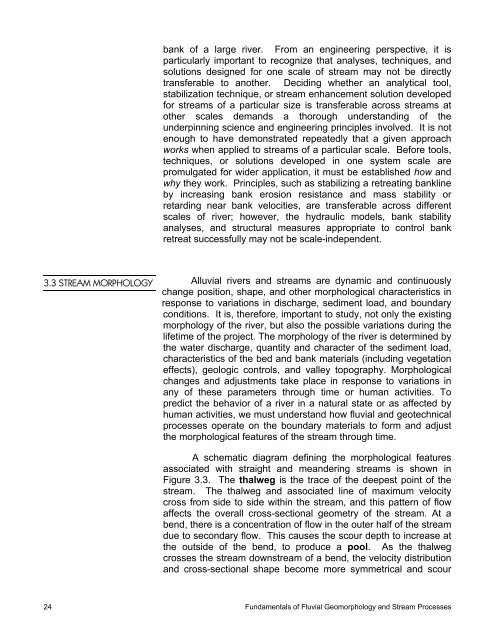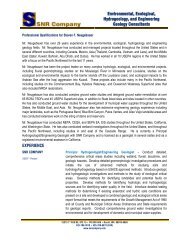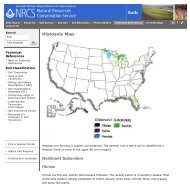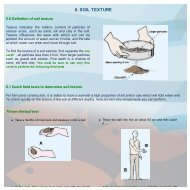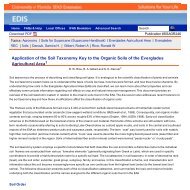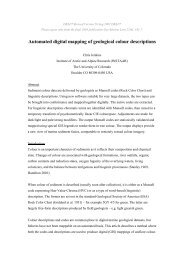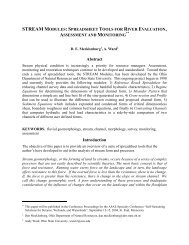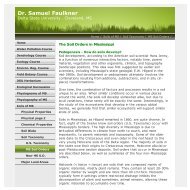chapter 3 fundamentals of fluvial geomorphology and stream ...
chapter 3 fundamentals of fluvial geomorphology and stream ...
chapter 3 fundamentals of fluvial geomorphology and stream ...
You also want an ePaper? Increase the reach of your titles
YUMPU automatically turns print PDFs into web optimized ePapers that Google loves.
ank <strong>of</strong> a large river. From an engineering perspective, it isparticularly important to recognize that analyses, techniques, <strong>and</strong>solutions designed for one scale <strong>of</strong> <strong>stream</strong> may not be directlytransferable to another. Deciding whether an analytical tool,stabilization technique, or <strong>stream</strong> enhancement solution developedfor <strong>stream</strong>s <strong>of</strong> a particular size is transferable across <strong>stream</strong>s atother scales dem<strong>and</strong>s a thorough underst<strong>and</strong>ing <strong>of</strong> theunderpinning science <strong>and</strong> engineering principles involved. It is notenough to have demonstrated repeatedly that a given approachworks when applied to <strong>stream</strong>s <strong>of</strong> a particular scale. Before tools,techniques, or solutions developed in one system scale arepromulgated for wider application, it must be established how <strong>and</strong>why they work. Principles, such as stabilizing a retreating banklineby increasing bank erosion resistance <strong>and</strong> mass stability orretarding near bank velocities, are transferable across differentscales <strong>of</strong> river; however, the hydraulic models, bank stabilityanalyses, <strong>and</strong> structural measures appropriate to control bankretreat successfully may not be scale-independent.3.3 STREAM MORPHOLOGYAlluvial rivers <strong>and</strong> <strong>stream</strong>s are dynamic <strong>and</strong> continuouslychange position, shape, <strong>and</strong> other morphological characteristics inresponse to variations in discharge, sediment load, <strong>and</strong> boundaryconditions. It is, therefore, important to study, not only the existingmorphology <strong>of</strong> the river, but also the possible variations during thelifetime <strong>of</strong> the project. The morphology <strong>of</strong> the river is determined bythe water discharge, quantity <strong>and</strong> character <strong>of</strong> the sediment load,characteristics <strong>of</strong> the bed <strong>and</strong> bank materials (including vegetationeffects), geologic controls, <strong>and</strong> valley topography. Morphologicalchanges <strong>and</strong> adjustments take place in response to variations inany <strong>of</strong> these parameters through time or human activities. Topredict the behavior <strong>of</strong> a river in a natural state or as affected byhuman activities, we must underst<strong>and</strong> how <strong>fluvial</strong> <strong>and</strong> geotechnicalprocesses operate on the boundary materials to form <strong>and</strong> adjustthe morphological features <strong>of</strong> the <strong>stream</strong> through time.A schematic diagram defining the morphological featuresassociated with straight <strong>and</strong> me<strong>and</strong>ering <strong>stream</strong>s is shown inFigure 3.3. The thalweg is the trace <strong>of</strong> the deepest point <strong>of</strong> the<strong>stream</strong>. The thalweg <strong>and</strong> associated line <strong>of</strong> maximum velocitycross from side to side within the <strong>stream</strong>, <strong>and</strong> this pattern <strong>of</strong> flowaffects the overall cross-sectional geometry <strong>of</strong> the <strong>stream</strong>. At abend, there is a concentration <strong>of</strong> flow in the outer half <strong>of</strong> the <strong>stream</strong>due to secondary flow. This causes the scour depth to increase atthe outside <strong>of</strong> the bend, to produce a pool. As the thalwegcrosses the <strong>stream</strong> down<strong>stream</strong> <strong>of</strong> a bend, the velocity distribution<strong>and</strong> cross-sectional shape become more symmetrical <strong>and</strong> scour24 Fundamentals <strong>of</strong> Fluvial Geomorphology <strong>and</strong> Stream Processes


